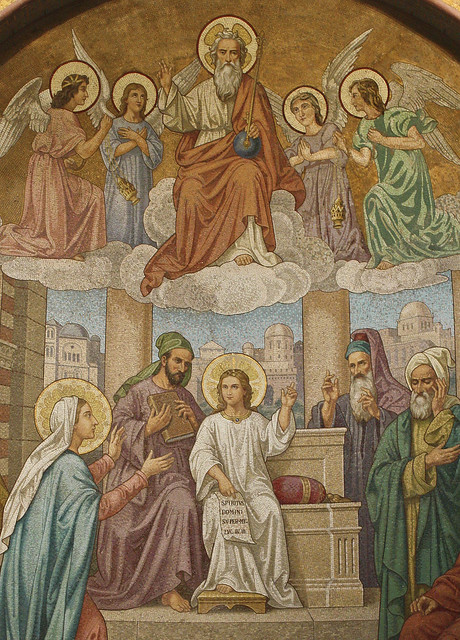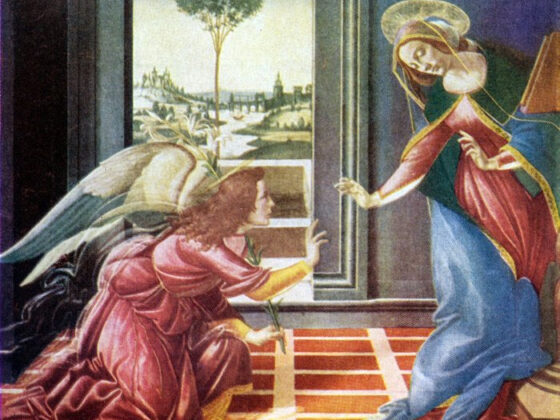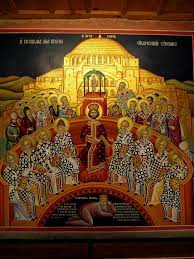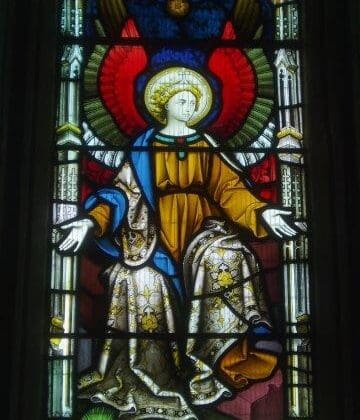A SERMON SERIES ON THE APOSTLES’ CREED
GOD THE FATHER AND CREATOR
Sermon Preached at Redeemer Anglican Church, Bellevue
June 20, 2021
Fourth Sunday after Pentecost (Fathers’ Day)
LESSONS: Psalm 97:1-7; Genesis 1:1-5; Ephesians 3:14-21; Luke 11:1-4,10-13
Last week I introduced the sermon series on the Apostles’ Creed by noting that the Bible itself, Old and New Testaments, contains creeds. In particular, the New Testament contains short creeds that are Trinitarian and that recount in brief the saving life death and resurrection of Jesus Christ.
If we look at the Apostles’ Creed, we shall easily see that it has three sections, devoted to the three Persons of the Trinity. The first is the shortest: “I believe in God the Father Almighty, Creator of heaven and earth.” It is short but it is packed with important meaning. I want to unpack two elements of this short section: who is God the Father, and how did He create the heaven and earth?
What about God the Father? Let me begin with an observation. I’ll bet you have heard more sermons about being a good parent or a good father – especially on Fathers Day – than you have heard about God the Father. Several decades ago, a leader in the charismatic movement wrote a book titled The Forgotten Father – a really good book that! The book itself was soon forgotten, although, when I was looking through the Trinity Seminary library on this subject, The Forgotten Father was the only book there!
There is a reason for this absence, I think: the doctrine of God the Father, like the Trinity itself, is a mystery. John’s Gospel states this plainly at the end of the prologue. Here is my translation: “No one has ever seen God [the Father]; the only-begotten Son, who dwells in the bosom of the Father, it is He who has now made the Father known” (John 1:18).
Later in the Gospel, the disciple Philip says to Jesus, “Show us the Father.” Jesus answers:
Have I been with you so long, and you still do not know me, Philip? Whoever has seen me has seen the Father. How can you say, “Show us the Father?” Do you not believe that I am in the Father and the Father is in me? (John 14:9-10a)
Of course, Jesus is not saying He is the Father nor is He saying that the name Father is mumbo-jumbo, unrelated to human fatherhood. But the passage warns us not to project our own experiences and relationships with our fathers – who may have been wonderful or horrible dads – on God. God the Father of Jesus as revealed in the Scriptures is both like and unlike any human father, and believing in Him has little to do with helpful tips on fathering.
The biblical doctrine of God the Father, like the biblical doctrine of the One God, is totally strange to the world’s religions. Polytheistic religions have father gods, but they tend to be either senile or promiscuous. Worse yet, many father gods have murdered their fathers. Zeus, for instance, overthrew his father Cronos, who himself had castrated his father Uranos. Although Zeus had a wife Hera, he raped a number of goddesses and women and even a man. Among the Canaanites, El was the senile father God, whereas Baal was the promiscuous god of fertility.
Among monotheistic religions, Islam sees Allah as an impersonal monad, beyond any human analogy, and is quite explicit in stating that he is not a father nor does he have a son. Among the Hebrews, God may on occasions be likened to a father, but he is never called “Father” as Jesus does. In one dispute with Jesus, the Jews allude to Jesus’ illegitimacy, arguing: “We were not born of sexual immorality. We have one Father, even God.” Jesus sees through this ruse and answers: “If God were your Father, you would love me, for I came from God and I am here. I came not of my own accord, but he sent me” (John 8:41-42).
We can only understand the Creed’s “I believe in God the Father” in the terms that Jesus set out when he taught his disciples to pray “Our Father in heaven,” which was his unique way of praying to “Abba, Father.” There is no “Father God,” no “Fatherhood of God and Brotherhood of Man” apart from “the God and Father of our Lord Jesus Christ,” a phrase that occurs in the salutations of most of Paul’s letters. There is no “Father in heaven” who is not the One God of the Old Testament, who identifies himself “I AM.”
The idea of God as essential Being is shared by the Father and the Son in the act of creation. Here is the way, Paul describes it says in the short creed I mentioned last week:
For although there may be so-called gods in heaven or on earth – as indeed there are many “gods” and many “lords” – yet for us there is one God, the Father, from whom are all things and for whom we exist, and one Lord, Jesus Christ, through whom are all things and through whom we exist. (1 Cor 8:5-6)
God the Father is the Source – “of all that is,” including us; Jesus Christ is the Mediator “through whom” all things, and we, come into existence.
The Church Fathers went one step further in inferring that the Father as the Source applies not only to the created order but to what is called the “essential Trinity” as well, God in His very Being. From all eternity, the Father has a priority within the Trinity. The Father begets the Son, and the Spirit proceeds from the Father. You can’t reverse the order without talking nonsense. Begetting, that’s what fathers do. If mothers are “birthing persons,” as some today suggest, then fathers are “begetting persons.” But to be more precise, God the Father is the only true Begetter: human fathers pro-create what God has already ordained.
In many cultures, the father is also the bearer of the family name. God the Father is also the name-bearer of the Trinity. This is why the vast majority New Testament references are to “God the Father” or “the God and Father of our Lord Jesus Christ.” In our Epistle today, Paul prays to “the Father, from whom every household in heaven and earth is named” (Eph 3:14-15). The universe is a divine patriarchy. This is not to say that the Father does not gladly share his “Godhood” with Jesus. Again, Paul describes the Son’s emptying himself on the Cross and then being exalted to God’s right hand and given the “Name that is above all names.” Jesus is God, no doubt about it.
God the Father is called “Almighty,” as Jesus makes clear in the first petition of the Prayer: “Thy Kingdom come.” God as King is a primary image in the Old Testament. Our Psalm today (Psalm 93) begins by acclaiming “the LORD reigneth.” But the divine King is also the supreme Delegator. From eternity He has enthroned His Son as Lord over the whole creation. Jesus is Lord (kyrios), Jesus is Messiah, anointed King, and this explains the second part of Paul’s greetings: “from God the Father and the Lord Jesus Messiah. The Risen Jesus shall reign over all history until the day when all is completed and He has defeated all His enemies including Death and hands the creation back to the Father and God will be all in all (1 Cor 15:28).
Now we come to the second aspect of the God the Father, according to the Creed: He is Creator of heaven and earth. This doctrine takes us back to the first verse of the Bible: “In beginning, God created the heaven and earth.” Again, many ancient religions have myths of the beginnings, but only Judaism, Islam and Christianity claim that God created out of nothing, that is, that God existed “before all worlds.” The Hebrew bara’, translated “create,” is a special word, distinct from the words to “make” or “shape.” God not only shapes the world, the cosmos, but He brings its building materials, its stuff into being, where there was nothing before. There was a time when the world was not.
Most heresies in the early church derived from philosophers and theologians who wanted to defend the sole supremacy of God the Father. The famous heretic Arius claimed that the Son was an exalted god-like but created being. “There was a time when he was not,” he taught. In effect, Arius made Jesus Christ a gigantic angel.
Speaking of angels, while the Apostles’ Creed says God the Father is “creator of heaven and earth,” the Nicene Creed adds “and of all things visible and invisible.” A brief excursus here: the phrase “all things visible and invisible” was changed in the 1979 Episcopal Prayer Book to “all things seen and unseen.” But these are not synonyms: “seen and unseen” suggests that heavenly and earthly things are in the same material order of nature. We just haven’t built a telescope or microscope powerful enough to see them, but someday we will. No, “visible and invisible” means that God has created entities that exist in a radically other realm or dimension. Paraphrasing Shakespeare’s Hamlet, there are more things in heaven and earth than can be discovered by modern science.
This distinction in wording is no minor matter. One of the offenses that certain people take to the Genesis creation account is the fact that God created light on the first day but the sun, moon and stars on the fourth day. The Bible is making an important point here: the fundamental laws of God that underlie all material reality precede it logically, if not temporally. Modern thought and much empirical science works from a philosophy of materialism, that matter is all there is. But truly, this is absurd.
Put philosophically, there has to be a metaphysics undergirding the physics of everything that is seen. There has to be something “prior,” what Dorothy Sayers called “the mind of the maker.” Recently, our family watched a movie titled The Man Who Knew Infinity. It is based on the true life story of a mathematician named Srinivasa Ramanujan, an impoverished Indian in Madras, who was a mathematical genius. He gets an opportunity to study at Cambridge University with a leading mathematician, D.L. Hardy. Hardy, a self-proclaimed atheist, recognizes Ramanujan’s genius, and under his tutelage Ramanujan devises the “partitions formula,” which solved a puzzle which many mathematicians had considered insoluble. At one point, Hardy asks Ramanujan where he gets his insight, and he says: “I get it from my God.” “An equation is nothing unless it expresses the mind of God,” he says. Hardy replies: “I just can’t believe in God, but I believe in you.” Hardy, it turns out, is the close-minded fundamentalist of the two.
The Christian doctrine of creation is not opposed to the discoveries of modern science. It simply says that there is a Wisdom, a Logos, that informs and indwells these discoveries but that is of a different order. The universe may have begun with the Big Bang in the order of time, but the laws of physics and time itself precede the Big Bang, again logically if not temporally.
Genesis goes on: “God said, “Let us make man in our image, after our likeness” (Gen 1:26-27). This little sentence reveals a lot about God and a lot about us. Put simply, God “talks to Himself” He creates our species male and female, and he makes us conversationalists too in our mutual intercourse. I had a student at Trinity once, who had converted from Judaism. When I asked her how this had happened, she said it was because of this verse. Nabeel Qureshi, a devout Muslim who converted to Christianity, compares Tahwid, the Islamic doctrine of Allah’s oneness and the Triune God of the Creed this way: “Allah is a monad: he is not inherently relational. Yahweh, on the other hand, is three persons, inherently relational.” Love is therefore the central principle of God. “God is love,” as St. John puts it simply (1 John 4:8). It is out of that selfless love that He created this universe.
The love of the Father is hinted at throughout the Old Testament, but it is Jesus who directs us to the depth of His fatherly love. Our preacher in Lent, talking about the Lord’s Prayer, drew our attention to the scandalous behavior of the prodigal father, who hitched up his robes and ran to meet his returning son. In our Gospel lesson today, Jesus moves rhetorically from the natural generosity of a father in providing food to his children, to the supernatural generosity of the heavenly Father, who gives His Holy Spirit to those who ask him” (Luke 11:13). How much more, St. Paul argues, will this Father “who did not spare his own Son but gave him up for us all … with him graciously give us all things” (Rom 8:32).
Fathers, mothers, sons and daughters, brothers and sisters. As we honor our earthly fathers this day, let us above all be sure to “bless the God and Father of our Lord Jesus Christ, who has blessed us in Christ with every spiritual blessing in the heavenly places” (Eph 1:3).
Let us pray:
O heavenly Father, you have filled the world with beauty: Open our eyes to behold your gracious hand in all your works; that, rejoicing in your whole creation, we may learn to serve you with gladness; for the sake of him through whom all things were made, your Son Jesus Christ our Lord. Amen.
GOD THE SON, TRUE GOD AND TRUE MAN
Sermon Preached at Redeemer Anglican Church, Bellevue
June 27, 2021
Fifth Sunday after Pentecost
LESSONS: Psalm 8; Hebrews 2:5-18; Mark 9:1-10
As we continue this series of Catechetical Sermons, let’s move forward from the affirmation of God the Father to God the Son. The Prayer Book version puts it this way:
I believe in God the Father Almighty, Creator of heaven and earth.
I believe in Jesus Christ, His only Son, our Lord.
There is a small discrepancy here: there is no second “I believe” in the original text, which says simply: “I believe in God the Father Almighty, Creator of Heaven and Earth; and in Jesus Christ, His only Son, our Lord.
The Prayer Book is bracketing the distinct Trinitarian Persons: the Father, the Son, and the Holy Spirit. While this emphasis is not incorrect, the original Creed is focusing on another matter: the unique nature of Jesus Christ, who is True God and True Man. The early church had to wrestle with two errors concerning the Son of God. One error called docetism claimed the Son only seemed to be human but was really a mask of the one God. The other error was Arianism, which claimed that the Son was a creature of God. Arius famously taught that “there was a time when he was not.”
Arius was half-right. It is true to say that there was a time when Jesus of Nazareth was not, which is any time B.C. Indeed that is precisely what B.C. and A.D. mark: at the turn of the ages, the Son of God became the son of Man, whose DNA came from a young woman of Nazareth. During the first thirty years A.D., the Son of God passed through every phase of human development, from the womb to the manger, from the carpenter’s bench to the Cross.
What the Creed teaches is that Jesus Christ is one with God the Father and Creator before all time, and one with the race of Adam, the Day Six creature of dust. We can only grasp the marvelous Good News of Jesus Christ when we can grasp His possessing both Natures – divine and human – fully, not half-and-half, but all in all. The Person of Jesus Christ is just as great a mystery as the Trinity, and it was just as hotly contested in the Church that produced the Creeds.
So with this creedal truth in mind, let’s look at two Old Testament texts. The first comes from the beginning: “So God created man in his own image, in the image of God he created him; male and female he created them” (Gen 1:27). God proceeds to bless them and give them dominion over all the creatures in earth and sky and sea, that is, of all things visible. But what about things invisible (to us)? The Bible says there is a spirit world. I wrote a book once titled Angels of Light and Powers of Darkness. I believe they are out there, or up there. Do you? And if so, aren’t they exalted above us (and fallen below us) in the hierarchy of heaven?
The Book of Genesis does not raise this question, but Psalm 8 does. Here’s my translation:
O LORD, our Lord, how majestic is your name in all the earth, you who sit enthroned above the heavens… When I look at your heavens, the work of your fingers, the moon and the stars, which you have set in place, what is man that you are mindful of him, and the son of man that you care for him? See, you have made him a little lower than the angels, yet you have crowned him with glory and honor and have given him dominion over the works of your hands and have put all things under his feet. (verses 1,2-5)
The Psalmist is looking through his telescope at the orderly cosmos, with God enthroned at the top, then the invisible world of the angels, and only then the earth creatures. And what amazes him is that God over-reaches and bypasses the spirit world and the angels to crown mankind. “What is man and the son of man?” he asks. The phrase “son of man” is particularly significant. A “son of man” is by definition “born of woman”; a “son of man” is mortal, he passes away like the flowers of the field (Isa 40:7-8). How can the divine, eternal Father, David asks, share a throne with such a weak and transient creature?
The Old Testament leaves this conundrum unanswered. The New Testament Letter to the Hebrews picks up the matter in light of Jesus. The author of Hebrews begins in much the way John’s Gospel begins with the Word-made-flesh, except in this case it is the Son-made-flesh:
Long ago, [he says], at many times and in many ways, God spoke to our fathers by the prophets, but in these last days he has spoken to us by his Son, whom he appointed the heir of all things, through whom also he created the world. He is the radiance of the glory of God and the exact imprint of his nature, and he upholds the universe by the word of his power. (Heb 1:1-3)
The Father created the world through His Son, and the Son is the exact imprint of His glorious nature – the Nicene Creed uses this language “being of one nature – one Being, one Substance – with the Father.” St. Paul puts this same doctrine in other words, saying “Christ is the image of the invisible God, the firstborn of all creation (Col 1:15). God can only beget God, and God’s Son is begotten of the Father before all worlds.
But then, how can He also be a mortal “son of Man,” an A.D. man. That is the great mystery. That is the glory of the Incarnation. In our Epistle today, the author of Hebrews reaches back to Psalm 8:
It has been testified somewhere, “What is man, that you are mindful of him, or the son of man, that you care for him? You made him for a little while lower than the angels; you have crowned him with glory and honor, putting everything in subjection under his feet.” (Heb 2:6-7)
The Father has crowned His Son Lord of everything from all eternity. He is the true Image of invisible God. He is the true Man, prophesied in the Psalm. But, Hebrews goes on to note: “At present” – in the “little while” of this age, B.C. and A.D – we do not yet see everything in subjection to him.” What do we see then?
We see him who for a little while was made lower than the angels, namely Jesus, crowned with glory and honor because of the suffering of death, so that by the grace of God he might taste death for everyone. (verse 9)
The decisive event of that little while, the hinge of history, happened on Calvary in 30 AD. There, in the unfathomable love of the Father, He crowned His Son. The crown of thorns which Jesus bore was just that, a crown of victory over sin and death. “It was fitting,” the author continues – “fitting!” – that [the Father], for whom and by whom all things exist, should make the founder of their salvation perfect through suffering in bringing many sons to glory” (verse 10).
The Creed gives the answer to the Psalmist’s question, “What is Man?” and “who is the Son of Man?” And this answer is full of Good News, news of comfort and joy because the “fittingness” of the Incarnation is also the fittingness of the Atonement, planned for all eternity. In his book Why God Became Man, St. Anselm argues the connection of Incarnation and Atonement in this way: the debt of sin is incurred by man alone against God, and God alone can cancel that debt, so only He who is God and Man can offer the perfect sacrifice for our redemption. The truth of the Creed needs to be sung, not merely said, as Charles Wesley knew when he wrote: “Amazing Love, how can it be, that Thou my God, shouldst die for me!”
So far I have been describing the divine Sonship of Christ. But of course, the Creed also speaks of Jesus Christ our Lord, and as I say, Jesus was a real man living in Palestine two thousand years ago. So let’s turn to the Gospels and see what they say about Jesus. In particular, did Jesus know from Christmas morning that He was the divine Son of YHWH, the God of Israel. Reading Christ’s mind is speculative, but I think one can say that like any human being, Jesus “increased in wisdom and stature” (Luke 2:52), including awareness of His Sonship. St. Luke gives a particular moment when the young Jesus, at the time of His Bar Mitzvah, separated Himself from His parents, telling them: “I must be about my Father’s business.” Already at this age, Jesus’ reference to “my Father” sets him apart from any Jew of that day.
More than a decade later, Jesus presented Himself for baptism by John, and the Father’s voice sounded from heaven: “You are my Son; this day I have begotten you.” This was the public announcement of Jesus’ Sonship – not, as some heretics ancient and modern have it, His divine begetting – and the start of His three-year ministry. He was immediately tested by Satan’s “If you are the Son of God…” and refused the bait. While He repeatedly demonstrated his Sonship through teaching and miracle, He refused to use the title “Son of God.” Instead, He referred to Himself as “Son of Man,” mortal man, even as He predicted His Resurrection and Second Coming. “The Son of Man,” he said, “is going to be delivered into the hands of men, and they will kill him. And when he is killed, after three days he will rise” (Mark 9:31).
As His time drew near and He prepared to go to Jerusalem and the Cross, another revelation of His Sonship occurred (our Gospel lesson today).
And after six days Jesus took with him Peter and James and John, and led them up a high mountain by themselves. And he was transfigured before them, and his clothes became radiant, intensely white, as no one on earth could bleach them. And there appeared to them Elijah with Moses, and they were talking with Jesus. (Mark 9:2-4)
The scene on the mountain recalls Moses, the Lawgiver, on Mount Sinai, asking to see God face to face. (He was denied.) Then there was Elijah, who was taken into heaven on a chariot and expected back before the Day of the Lord. (He came girded in camel’s hair and was beheaded.) Moses and Elijah were seen talking to Jesus: He was transfigured in glory; they were not. Their inspired words in the Old Testament point to Jesus, but it is God the Father Himself who speaks the final word: “This is my beloved Son; listen to Him.”
Flabbergasted, Peter wasn’t listening: “Rabbi,” he says, “it is good that we are here. Let us make three shrines, one for you and one for Moses and one for Elijah.” One for the Lawgiver, one for the Prophet, and one for the Rabbi here!” Once the vision ceased, of course, it was only the human Jesus who remained with them and told them not to repeat this vision until He had risen from the dead, which was not hard to do, since they did not know what He meant. But the day of Pentecost soon came when Peter would proclaim:
“This Jesus God raised up, and of that we all are witnesses…. Let all the house of Israel therefore know for certain that God has made him both Lord and Christ, this Jesus whom you crucified” (Acts 2:32, 36).
Brothers and sisters, the Creeds say nothing that is not found in the Bible. It is simply expressed in a concise formula. But the early church did not stop with Creeds alone. One of the earliest hymns is called the “Te Deum,” which is directed to the Triune God. Here is the section of praise to God the Son:
You Christ, are the king of glory,
the eternal Son of the Father.
When you took our flesh to set us free
you humbly chose the Virgin’s womb.
You overcame the sting of death
and opened the kingdom of heaven to all believers.
You are seated at God’s right hand in glory.
We believe that you will come to be our judge.
Come then, Lord [“Maranatha!”] and help your people,
bought with the price of your own blood,
And bring us with your saints
to glory everlasting.
The Creed is all about love, God’s love for us. “For God so loved the world, that he gave his only Son, that whoever believes in him should not perish but have eternal life (John 3:16). Another hymn attributed to Thomas à Kempis a thousand years after the Te Deum sounds the same praise of God the Son. It begins.
O love, how deep, how broad, how high,
how passing thought and fantasy,
that God, the Son of God, should take
our mortal form for mortals’ sake!
It concludes with a Trinitarian doxology:
All glory to our Lord and God
for love so deep, so high, so broad;
the Trinity whom we adore
forever and forevermore.





